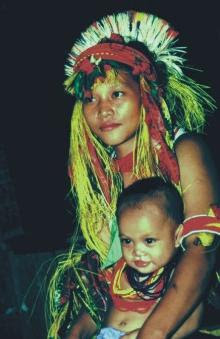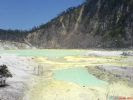Relief Borobudur Temple
 The
The  For each direction there are ninety-two Dhyani Buddha statues and 1,460 relief scenes. The lowest level has 160 reliefs depicting cause and effect; the middle level contains various stories of the Buddha's life from the Jataka Tales; the highest level has no reliefs or decorations whatsoever but has a balcony, square in shape with round walls: a circle without beginning or end. Here is the place of the ninety-two Vajrasattvas or Dhyani Buddhastucked into small stupas. Each of these statues has a mudra (hand gesture) indicating one of the five directions: east, with the mudra of calling the earth to witness; south, with the hand position of blessing; west, with the gesture of meditation; north, the mudra of fearlessness; and the centre with the gesture of teaching.
For each direction there are ninety-two Dhyani Buddha statues and 1,460 relief scenes. The lowest level has 160 reliefs depicting cause and effect; the middle level contains various stories of the Buddha's life from the Jataka Tales; the highest level has no reliefs or decorations whatsoever but has a balcony, square in shape with round walls: a circle without beginning or end. Here is the place of the ninety-two Vajrasattvas or Dhyani Buddhastucked into small stupas. Each of these statues has a mudra (hand gesture) indicating one of the five directions: east, with the mudra of calling the earth to witness; south, with the hand position of blessing; west, with the gesture of meditation; north, the mudra of fearlessness; and the centre with the gesture of teaching.
Besides being the highest symbol of Buddhism, the Borobodur stupa is also a replica of the universe. It symbolises the  micro-cosmos, which is divided into three levels, in which man's world of desire is influenced by negative impulses; the middle level, the world in which man has control of his negative impulses and uses his positive impulses; the highest level, in which the world of man is no longer bounded by physical and worldly ancient desire.
micro-cosmos, which is divided into three levels, in which man's world of desire is influenced by negative impulses; the middle level, the world in which man has control of his negative impulses and uses his positive impulses; the highest level, in which the world of man is no longer bounded by physical and worldly ancient desire.
It is devotional practice to circumambulate around the galleries and terraces always turning to the left and keeping the edifice to  the right while either chanting or meditating. In total, Borobodur represents the ten levels of a Bodhisattva's life which he or she must develop to become a Buddha or an awakened one.
the right while either chanting or meditating. In total, Borobodur represents the ten levels of a Bodhisattva's life which he or she must develop to become a Buddha or an awakened one.
The
1.Design of
Ever since the first excavation, most experts speculated on the exact shape of the temple. Hoenig, in his book “Das form problem des Borobudur” speculate that the original form of
According to Stutterheim, the overall form of
The relief of
Division of panels are: the first panel expressed a heavenly being in sitting position, on both side of this panel are small panel with a small standing statue. This figures are repeated 26 times for each side of the wall. Between the panels is carved three bodies, a male flanked by two women.
2. Relief
There was a long series of main relieves at the first alley, either at the main wall or at the inner side of Kutamara wall. Relieves at the Kutamara wall depicted Jataka's and Awadana's, a story of Buddha's life which expressed as Bodhisatwa, due to his good deeds in the past. Sometimes, Buddha is expressed in the form of animals such as rabbit, monkeys etc. As it was told in animated stories, the story was adopted from Sanskrit book, Jatakamala. Only one third of the relieves were known, the rest was still unclear.
The lower relieves of the main wall contained the same story. The upper relieves also had the same story as the lower one. The story contained the life of Buddha consisting of 120 frames until he began teaching Buddha religion. The first frame began from the South of stairway of the curved gate at the East, and follow the path of the sun (the temple on the right side). The life story of Buddha was adopted from Lalitawistara book.
At the second alley, Jataka and Awadana story were continued on the inner side of Utamara, and on the main wall, story was began with stories adopted from Gandhawyuha. This story was so long that it occupied the main wall and inner side wall of Utamara at the third and fourth alley. The story showed the adventure of a Sudhana who met Bodhisatwa Maytreya (the future Buddha) to have religious lesson from the Buddha. Later on, the Sudhana met with Bodhisatwa Mandjusri, and finally he met with Dyani Bodhisatwa Samanta Badra, who gave the highest wisdom. Most of those stories expressed the use of spiritual strength and unusual happenings.
There were many beautiful ornaments inscripted at the wall of the fourth alley, because the fifth alley did not contained any ornaments. The fifth alley is a transitional alley to the next platform, the round platform. The next round platforms also did not contained any ornaments at all







src="http://pagead2.googlesyndication.com/pagead/show_ads.js">
.
src="http://pagead2.googlesyndication.com/pagead/show_ads.js">
src="http://pagead2.googlesyndication.com/pagead/show_ads.js" type="text/javascript">
src="http://pagead2.googlesyndication.com/pagead/show_ads.js" type="text/javascript">


Comments
Post a Comment